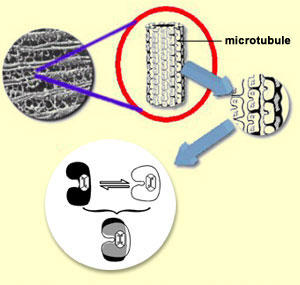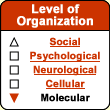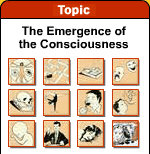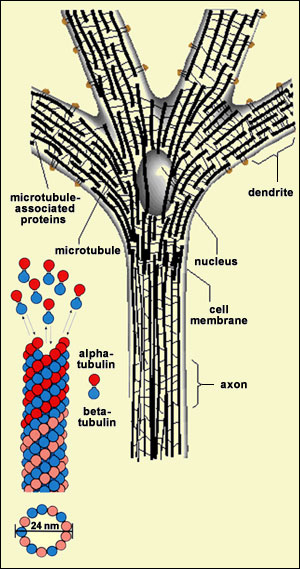|
|
| |
 |
| The Sense of Self |  |
| | |


A famous mathematical theorem, the
incompleteness theorem, or Gödel’s theorem, proposed
by Kurt Gödel (1906-1978), plays a role in Penrose’s
theory. This theorem shows that no system of axioms is powerful enough to generate
all mathematical truths. According to Penrose, this shows that the human mind
must have some non-algorithmic capabilities that go beyond axioms and rules. And
indeed, the human mind can recognize as true those parts of arithmetic that transcend
the systems of axioms. Not all logicians agree with
this interpretation, but Penrose nevertheless suggests that this non-algorithmic
aspect of consciousness comes from its connections with quantum physics. |
Karl Pribram developed
a “holographic” model of the operation
of the human brain, inspired by the discovery of the first holograms in the mid-1960s.
In a hologram, all of the pieces of information recorded in the form of interference
patterns on each fragment of the photographic medium can be used to reconstruct
the entire image and to provide a three-dimensional view of it as a whole. By
analogy, Pribram believes that memories are not stored in cells at specific sites
in the brain, but are rather contained in the wave-interference patterns the run
through it. Developed by Pribram in collaboration
with quantum physicist David Bohm, this model suggests that consciousness
may emerge through the processing of information among dendrites and that the
action
potentials propagated along axons might in contrast be the substrate for
the brain’s non-conscious activities. | | |
| CAN QUANTUM EFFECTS EXPLAIN CONSCIOUSNESS? |
|
Physics can be said
to offer two main levels of explanation: the familiar level that is used every
day to describe large-scale objects, and the quantum level, which is used to describe
the infinitely small and is governed by Schrödinger’s
equation. Both of these levels are completely deterministic and computable.
But at the quantum level, superposed states are possible, whereas at our familiar,
macroscopic level, only one of these multiple states can exist. This explains
why, when we make an observation at our familiar level, the superposed states
must collapse into a single, unique possibility. On
the basis of this classical interpretation of quantum mechanics, physicists such
as Eugene Wigner have come up with a startling hypothesis: that
consciousness can cause this collapse of the wave function and thus determine
the conscious contents of the brain. A number of authors, such as Henry
Stapp, have gone on to build sophisticated models around this idea. But others,
such as English physicist and mathematician Roger Penrose, have
distanced themselves from these conventional interpretations of the collapse of
the wave function. For Penrose, these interpretations are only approximations
that will have to be refined through future developments in quantum theory. Penrose
has therefore proposed his theory of objective reduction.
He describes objective reduction as a process that is gravitational in nature,
but not local: in other words, it may exert effects from a distance. For these
reasons, it could connect things that are distant in space, thus opening the possibilities
of quantum coherence on a large scale and of “non-computable”phenomena
that our brains could put to use.
But where exactly might
these phenomena occur in the human brain? To answer this question, Penrose turns
to the hypothesis offered by American anaethesiologist Stuart Hameroff,
that consciousness emerges from quantum coherence at the level of the microtubules.
As their name implies, microtubules are tiny tubes, composed of proteins, that
are found in all cells of the human body, including the neurons. The microtubules
form a sort of cytoskeleton for the cells and play a role in cell division as
well as in the transport of organelles
inside the cells. Microtubules
are composed of tubulin dimers formed into spirals to produce small tubes
about 24 nanometres in diameter. These molecules of tubulin may be in two different
states—extended or contracted—which might, according to Hameroff,
result from a superposition of quantum states. Penrose and Hameroff investigated
microtubules because their small size and spiral protein structure would provide
the essential conditions to orchestrate quantum collapses. For quantum coherence
processes to occur, they must remain reasonably isolated from the external environment,
and according to these authors, microtubules fulfil this condition. | |
 | Penrose
and Hameroff state that this model might explain several of the fundamental characteristics
of consciousness. Thus, the possibility of objective reduction effects from a
distance might account for the unity of consciousness, and quantum indeterminism
might be the source of free
will. Penrose adds that his theory
might even help to explain the strange
results of Libet’s experiment, because in Penrose’s view, when
conventional reasoning about the temporal sequence of events leads us to contradictory
conclusions (such as the impression of influencing the past, on time scales on
the order of half a second), this constitutes a strong indication that quantum
effects are at work. | Penrose
and Hameroff’s model has received serious criticism, notably from philosophers
Rick Grush and Patricia
Churchland, who raise several objections that lead them to reject
this model in its entirety. First of all, Grush and Churchland point out that
microtubules are found in all plant and animal cells, and not only in the neurons
of the human brain. These authors also state that some chemicals that are known
to destroy microtubules do not seem to have any major effects on consciousness.
They point out that a number of anaesthetics act without affecting the microtubules.
And lastly, they note that there is no evidence that microtubules are involved
in other phenomena that cause major changes in states of consciousness, such as
the sleep/dream/wake
cycle. Strictly in terms of physics,
one classic criticism is that offered by Max Tegmark, who states
that the temperature of the brain is too high for elementary particles to remain
in superposed states long enough for neuronal processes to be affected by them.
Grush and Churchland add that microtubules cannot achieve the conditions of purity
and isolation required by Penrose’s theory; they also argue that quantum
effects cannot be transmitted from one microtubule to another as they would have
to be to explain the unity of consciousness. In Grush and Churchland’s view,
Penrose’s theory also fails to provide any valid explanations of the way
that quantum effects could interact with neurons or neurotransmitters when microtubules
are supposed to be isolated from their environment. Another
objection addresses one of the strengths of Penrose and Hameroff’s model,
which is, according to its authors, that it can account for the unity of consciousness.
But if this impression of the unity of human consciousness should prove to be
an
illusion, as some other authors believe, then once again, explanations based
on non-locality and quantum coherence would become irrelevant. Other
critics have questioned whether, in the end, Penrose and Hameroff’s theory
really has anything to do with consciousness or whether it actually simply replaces
one mystery—subjective
experience—with another—quantum coherence in microtubules. Grush
and Churchland have even gone so far as to ask whether the reason that Penrose
and Hameroff’s model became so popular might be that whereas reducing consciousness
to mere neural
correlates has always seemed somehow degrading to some people, the quantum
alternative enables some of the comforting mystery surrounding consciousness to
be preserved. That said, it is worth
recalling here what Danish physicist Niels Bohr, the father of quantum physics
and a professor of Werner
Heisenberg’s, said one day to a young physicist: “We
are all agreed that your theory is crazy. The question which divides us is whether
it is crazy enough to have a chance of being correct.”
Another hypothesis about consciousness
that draws on quantum physics dates back to research done by Ricciardi
and Umezawa in the 1960s. This hypothesis treats mental states, and in
particular memories, as “vacuum states of the quantum field”. It takes
neurobiological research on consciousness into account, inasmuch as it regards
these “vacuum states” as consisting of neuronal
assemblies corresponding to memory contents, and posits that it is the activation
of these assemblies, triggered by external stimuli, that results in states of
excitation that enable the memory content encoded in the “vacuum state”
to be recalled. As if that were not already pretty
complicated, in the mid-1960s, Italian physicist Giuseppe Vitiello
began to improve upon this hypothesis by adding the concepts of dissipative
structures, chaos, and quantum noise.
In Vitiello’s model, the fact that the brain is an open system in constant
interaction with its environment is what accounts for its vast memory capacity.
But this model still has some conceptual ambiguities that need to be clarified,
in particular between mental and material states. |
|
|






